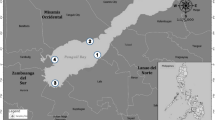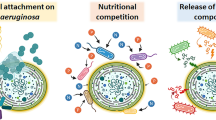Abstract
A microcosm experiment was setup to examine (1) the effect of phenanthrene contamination on meiofauna and bacteria communities and (2) the effects of different bioremediation strategies on phenanthrene degradation and on the community structure of free-living marine nematodes. Sediments from Bizerte lagoon were contaminated with (100 mg kg−1) phenanthrene and effects were examined after 20 days. Biostimulation (addition of nitrogen and phosphorus fertilizer or mineral salt medium) and bioaugmentation (inoculation of a hydrocarbonoclastic bacterium) were used as bioremediation treatments. Bacterial biomass was estimated using flow cytometry. Meiofauna was counted and identified at the higher taxon level using a stereomicroscope. Nematodes, comprising approximately two thirds of total meiofauna abundance, were identified to genus or species. Phenanthrene contamination had a severe impact on bacteria and meiofauna abundances with a strong decrease of nematodes with a complete disappearance of polychaetes and copepods. Bioremediation counter balanced the toxic effects of phenanthrene since meiofauna and bacteria abundances were significantly higher (p < 0.01) than those observed in phenanthrene contamination. Up to 98 % of phenanthrene removal was observed. In response to phenanthrene contamination, the nematode species had different behavior: Daptonema fallax was eliminated in contaminated microcosms, suggesting that it is an intolerant species to phenanthrene; Neochromadora peocilosoma, Spirinia parasitifera, and Odontophora n. sp., which significantly (p < 0.05) increased in contaminated microcosms, could be considered as "opportunistic" species to phenanthrene whereas Anticoma acuminata and Calomicrolaimus honestus increased in the treatment combining biostimulation and bioaugmentation. Phenanthrene had a significant effect on meiofaunal and bacterial abundances (p < 0.05), with a strong reduction of density and change in the nematode communities. Biostimulation using mineral salt medium strongly enhanced phenanthrene removal, leading to a decrease of its toxicity. This finding opens exciting axes for the future use of biostimulation to reduce toxic effects of PAHs for meiofauna and bacteria in lagoon sediment.





Similar content being viewed by others
References
Albers P (2003) Petroleum and individual polycyclic aromatic hydrocarbons. In: Hoffman DJ, Rattner BA, Burton GA, Cairns J (eds) Handbook of ecotoxicology. Lewis Publishers, New York
Ana DC, Renata G, Martin S, Marta F, Maria ARH (2007) Biochemical and behavioral responses in gilthead seabream (Sparus aurata) to phenanthrene. J Exp Mar Biol Ecol 347:109–122
Balba MT, Al-Awadhi N, Al-Daher R (1998) Bioremediation of oil-contaminated soil: microbiological methods for feasibility assessment and field evaluation. J Microbiol Methods 32:155–164
Ben Said O, Goni-Urriza MS, El Bour M, Dellali M, Aissa P, Duran R (2008) Characterization of aerobic polycyclic aromatic hydrocarbon-degrading bacteria from Bizerte lagoon sediments, Tunisia. J Appl Microbiol 104:987–997
Beolchini F, Rocchetti L, Regoli F, Dell’Anno A (2010) Bioremediation of marine sediments contaminated by hydrocarbons: experimental analysis and kinetic modeling. J Hazard Mater 182:403–407
Beyrem H, Aissa P (2000) Free-living nematodes, bio-indicators of the evolution of hydrocarbon concentrations in the bay of Bizerta (Tunisia). Cah Biol Mar 41:329–342
Beyrem H, Louati H, Essid N, Aissa P, Mahmoudi E (2010) Effects of two lubricant oils on marine nematode assemblages in a laboratory microcosm experiment. Mar Environ Res 69:248–253
Boufahja F, Sellami B, Dellali M, Aissa P, Mahmoudi E, Beyrem H (2011) A microcosm experiment on the effects of permethrin on a free-living nematode assemblage. Nematology 13:901–909
Broeks A, Gerrard B, Allikmets R, Dean M, Plasterk RHA (1996) Homologues of the human multidrug resistance genes MRP and MDR contribute to heavy metal resistance in the soil nematode Caenorhabditis elegans. Embo J 15:6132–6143
Burton SM, Rundle SD, Jones MB (2001) The relationship between trace metal contamination and stream meiofauna. Environ Pollut 111:159–167
Cerniglia CE (1993) Biodegradation of polycyclic aromatic hydrocarbons. Curr Opin Biotechnol 4:331–338
Clarke KR (1993) Non-parametric multivariate analyses of changes in community structure. Aust J Ecol 18:117–143
Clarke KR, Warwick RM (2001) Changes in marine communities: an approach to statistical analysis and interpretation. PRIMER-E, Plymouth
Cui YX, McBride SJ, Boyd WA, Alper S, Freedman JH (2007) Toxicogenomic analysis of Caenorhabditis elegans reveals novel genes and pathways involved in the resistance to cadmium toxicity. Genome Biol 8
Duhamel S, Jacquet S (2006) Flow cytometric analysis of bacteria- and virus-like particles in lake sediments. J Microbiol Methods 64:316–332
Einsporn S, Koehler A (2008) Immuno-localisations (GSSP) of subcellular accumulation sites of phenanthrene, aroclor 1254 and lead (Pb) in relation to cytopathologies in the gills and digestive gland of the mussel Mytilus edulis. Mar Environ Res 66:185–186
Engraff M, Solere C, Smith KEC, Mayer P, Dahllof I (2011) Aquatic toxicity of PAHs and PAH mixtures at saturation to benthic amphipods: linking toxic effects to chemical activity. Aquat Toxicol 102:142–149
Gerlach SA (1978) Food chain relationships in subtidal silty sand, marine sediments and the role of meiofauna in stimulating bacterial productivity. Oecologia (Berl) 33:55–69
Gyedu-Ababio TK, Baird D (2006) Response of meiofauna and nematode communities to increased levels of contaminants in a laboratory microcosm experiment. Ecotoxicol Environ Saf 63:443–450
Hale SE, Meynet P, Davenport RJ, Jones DM, Werner D (2010) Changes in polycyclic aromatic hydrocarbon availability in River Tyne sediment following bioremediation treatments or activated carbon amendment. Water Res 44:4529–4536
Haritash AK, Kaushik CP (2009) Biodegradation aspects of polycyclic aromatic hydrocarbons (PAHs): a review. J Hazard Mater 169:1–15
Hedfi A, Mahmoudi E, Boufahja F, Beyrem H, Aissa P (2007) Effects of increasing levels of nickel contamination on structure of offshore nematode communities in experimental microcosms. Bull Environ Contam Toxicol 79:345–349
Hlaili AS, Chikhaoui MA, El Grami B, Mabrouk HH (2006) Effects of n and p supply on phytoplankton in Bizerte Lagoon (western Mediterranean). J Exp Mar Biol Ecol 333:79–96
IARC (2010) Working Group on the Evaluation of Carcinogenic Risks to Humans, Some Non-heterocyclic Polycyclic Aromatic Hydrocarbon Related Industrial Exposures. IARC monographs on the evaluation of carinogenic risks to humans
Jacques RJS, Okeke BC, Bento FM, Teixeira AS, Peralba MCR, Camargo FAO (2008) Microbial consortium bioaugmentation of a polycyclic aromatic hydrocarbons contaminated soil. Bioresour Technol 99:2637–2643
Keith LH, Telliard WA (1979) Priority pollutants—a perspective view. Environ Sci Technol 13:416–423
Lindgren JF, Hassellov IM, Dahllof I (2012) Meiofaunal and bacterial community response to diesel additions in a microcosm study. Mar Pollut Bull 64:595–601
Lotufo GR (1997) Toxicity of sediment-associated PAHs to an estuarine copepod: effects on survival, feeding, reproduction and behavior. Mar Environ Res 44:149–166
Louati A, Elleuch B, Kallel M, Saliot A, Dagaut J, Oudot J (2001) Hydrocarbon contamination of coastal sediments from the Sfax area (Tunisia), Mediterranean Sea. Mar Pollut Bull 42:445–452
Louati H, Ben Said O, Got P, Soltani A, Mahmoudi E, Cravo-Laureau C, Duran R, Aissa P, Pringault O (2013a) Microbial community responses to bioremediation treatments for the mitigation of low-dose anthracene in marine coastal sediments of Bizerte lagoon (Tunisia). Environ Sci Pollut Res 20:300–310
Louati H, Ben Said O, Soltani A, Got P, Mahmoudi E, Cravo-Laureau C, Duran R, Aissa P, Pringault O (2013b) The roles of biological interactions and pollutant contamination in shaping microbial benthic community structure. Chemosphere 10.1016/j.chemosphere.2013.09.069
Mahmoudi E, Essid N, Beyrem H, Hedfi A, Boufahja F, Vitiello P, Aissa P (2005) Effects of hydrocarbon contamination on a free living marine nematode community: results from microcosm experiments. Mar Pollut Bull 50:1197–1204
Mahmoudi E, Essid N, Beyrem H, Hedfi A, Boufahja F, Vitiello P, Aissa P (2007) Individual and combined effects of lead and zinc on a free-living marine nematode community: results from microcosm experiments. J Exp Mar Biol Ecol 343:217–226
Marie D, Partensky F, Jacquet S, Vaulot D (1997) Enumeration and cell cycle analysis of natural populations of marine picoplankton by flow cytometry using the nucleic acid stain SYBR Green I. Appl Environ Microbiol 63:186–193
Muckian LM, Grant RJ, Clipson NJW, Doyle EM (2009) Bacterial community dynamics during bioremediation of phenanthrene- and fluoranthene-amended soil. Int Biodeterior Biodegr 63:52–56
Ouyang Y (2006) Phenanthrene pathway map. http://umbbd.msi.umn.edu/pha/pha_map.html
Platt HM, Warwick RM (1983) Free living marine nematodes. Part I. British enoplids. Synopses of the British fauna no 28. Cambridge University Press, Cambridge
Platt HM, Warwick RM (1988) Free living marine nematodes. Part II. British chromadorids. Synopses of the British fauna no 38. E.J Brill, Leiden
Shailaja MS, D’Silva C (2003) Evaluation of impact of PAH on a tropical fish, Oreochromis mossambicus using multiple biomarkers. Chemosphere 53:835–841
Smith VH, Graham DW, Cleland DD (1998) Application of resource-ratio theory to hydrocarbon biodegradation. Environ Sci Technol 32:3386–3395
Soclo HH, Garrigues P, Ewald M (2000) Origin of polycyclic aromatic hydrocarbons (PAHs) in coastal marine sediments: case studies in Cotonou (Benin) and Aquitaine (France) areas. Mar Pollut Bull 40:387–396
Stringer TJ, Glover CN, Keesing V, Northcott GL, Tremblay LA (2012) Development of a harpacticoid copepod bioassay: selection of species and relative sensitivity to zinc, atrazine and phenanthrene. Ecotoxicol Environ Saf 80:363–371
Suderman K, Thistle D (2003) Spills of fuel oil #6 and Orimulsion can have indistinguishable effects on the benthic meiofauna. Mar Pollut Bull 46:49–55
Sundback K, Alsterberg C, Larson F (2010) Effects of multiple stressors on marine shallow-water sediments: response of microalgae and meiofauna to nutrient-toxicant exposure. J Exp Mar Biol Ecol 388:39–50
Ulanowicz RE, Goerner SJ, Lietaer B, Gomez R (2009) Quantifying sustainability: resilience, efficiency and the return of information theory. Ecol Complex 6:27–36
Verrhiest GJ, Clement B, Volat B, Montuelle B, Perrodin Y (2002) Interactions between a polycyclic aromatic hydrocarbon mixture and the microbial communities in a natural freshwater sediment. Chemosphere 46:187–196
Warwick RM, Platt HM, Somerfield PJ (1998) Free-living marine nematodes. Part III. British monhysterids. Synopses of the British fauna (new series). 53. Studies Council Shrewsbury, UK
Yang Y, Zhang N, Xue M, Tao S (2010) Impact of soil organic matter on the distribution of polycyclic aromatic hydrocarbons (PAHs) in soils. Environ Pollut 158:2170–2174
Yu KSH, Wong AHY, Yau KWY, Wong YS, Tam NFY (2005) Natural attenuation, biostimulation and bioaugmentation on biodegradation of polycyclic aromatic hydrocarbons (PAHs) in mangrove sediments. Mar Pollut Bull 51:1071–1077
Zhou HW, Wong AHY, Yu RMK, Park YD, Wong YS, Tam NFY (2009) Polycyclic aromatic hydrocarbon-induced structural shift of bacterial communities in mangrove sediment. Microb Ecol 58:153–160
Acknowledgments
This work was supported by a funding of the CMCU program (PHC-UTIQUE, n° 09G 0189), Centre National de la Recherche Scientifique (CNRS), Institut de Recherche pour le Développement (IRD), and the Faculté des Sciences de Bizerte (FSB).
Author information
Authors and Affiliations
Corresponding author
Additional information
Responsibility editor: Philippe Garrigues
Rights and permissions
About this article
Cite this article
Louati, H., Said, O.B., Soltani, A. et al. Biostimulation as an attractive technique to reduce phenanthrene toxicity for meiofauna and bacteria in lagoon sediment. Environ Sci Pollut Res 21, 3670–3679 (2014). https://doi.org/10.1007/s11356-013-2330-5
Received:
Accepted:
Published:
Issue Date:
DOI: https://doi.org/10.1007/s11356-013-2330-5




